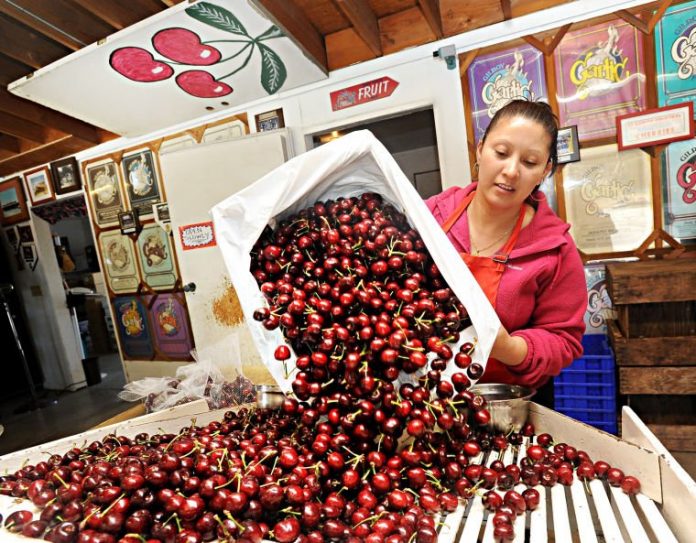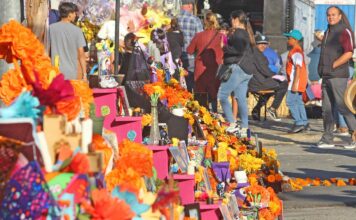
Gilroy and Morgan Hill Cherry farmer Ralph Santos said this year he got half of the average total harvest, which workers picked twice as fast, and slim pickings for you-pick cherry farmer Kathy Kraintz prompted the closure of her small-scale Silicon Valley agritourism attraction Lazy K Ranch to the public.
Hollister-based Rajkovich Brothers Orchards owner George Rajkovich’s 76-year career in the cherry industry hasn’t witnessed a year like 2014 with harvests pulling in a meager 10 percent of normal.
Cherry farmers from across South County reported what they’re calling historically low figures in tune with statewide agricultural projections calling for a less-than-stellar 2014. Despite some local variance in how hard hit growers actually were, numbers were down across the board, several reported.
“If you go back 10 to 12 years, this is the lowest crop we’ve had,” Santos said. “These fluctuations happen.”
According to a June 25 crop report issued by the USDA, the cherry harvest wrapped up mid-June. Warm and dry winter weather reduced chilling hours while poor pollination resulted in minimal set and record-low yield, according to the report.
“Everybody is hurting the same as you guys over there, if not worse,” said Joseph A. Grant, farm advisor, fruits and nuts specialist at U.C. Davis Cooperative Extension San Joaquin County. “This whole thing was statewide. Many of our guys didn’t even pick over here it was so bad.”
According to the report, California sweet cherry growers harvested 30,000 tons, down from 92,300 tons in 2012. Santa Clara County’s crop report detailing the exact gross value and production of cherries was not available for 2014 as of press time.
“Classic non-chill” is how cherry grower Mitch Mariani described weather conditions this year. According to growers, cherries need “rest time” during the winter, but there was not enough this year.
For Mitch, it meant about 30 percent of his normal crop. His brother, Andy Mariani of Andy’s Orchards, said he harvested roughly 20 percent of normal. Rajkovich reported about 10 percent of normal, and Santos reported about 30 percent.
“We thought we were getting enough chill, but there must be a flaw in the computer model that the computer was using that fooled us on this one,” Mitch said. “The pattern of cropping seems to suggest we didn’t have enough cold weather.”
Three factors could have played into this year’s shortage: chilling patterns, lack of rain and heat soaring into the 85-90 degree range during blossoming, which killed pollen, according to Mitch.
“We believe any and all of those combined probably contributed to it,” he said. “This is one of the worst cherry crop years I’ve ever seen.”
Despite the lack of crop volume, farmers remain optimistic that the weather conditions won’t deter the high consumer demand for their product. Andy Mariani said he placed up placards for customers explaining why the price hikes were occurring.
Low cherry harvest yields mean there’s still room for a little humor.
“We did very well,” Rajkovich joked.
Now in her third year, Kraintz’s eight-acre agri-tourism organic farm of Bing and Brooks cherries off Highway 152 east and Cañada Road wasn’t exempt from a good laugh.
“It’s more like Easter egg hunting,” Kraintz joked. “Every once in awhile you’ll find a tree with some on it, but it’s very few and far in between.”
Economic repercussions of the low yields reverberated throughout the industry. Millions of dollars invested in electronic sorting equipment in the Central Valley prompted by labor availability is also a concern for the 2014 harvest, according to Grant.
“Some guys have brand new lines this year,” Grant said.
Grant said that without a significant crop in 2014 “these cherries are going to grow a lot better” in 2015.
Even for small-scale growers like Kraintz, it’s an expensive hobby during a year like 2014 with no income. Kraintz is looking toward next year to support her hobby.
“For us it is a very expensive hobby during a year like this with no income,” Kraintz said. “Hopefully we can make it up next year.”
Despite lack of quantity, fruit quality is high, several local growers confirmed. With high consumer demand driving prices upward, several farmers said they were worried about harvest penciling out for their bottom lines. Fruit sizes were “surprisingly a little off,” but for the most part the quality and the sizes were pretty good, according to Andy.
Some years farmers see a lot of fruit, but also you get a rain event just prior to picking, and fruit gets cracked and moldy, whereas this year Andy said the weather was mild through harvest.
“Quality was actually pretty good,” he said.
Rajkovich added, “The quality was good but just not enough there to make ends meet really.”
On Rajkovich’s roughly 300 acres, the farm usually nets 2.5 million boxes per year; this year harvest results plummeted to 20,000.
With a light harvest year in 2013, 63-year-old Santos said he was expecting a larger harvest with a season starting with ideal weather conditions and the alternate bearing trends of trees in anticipation of a big crop in 2014.
“This year it’s going to be pretty lean,” Santos said. “That’s the nature of the beast in the agricultural business, which means you’re in it for the longhaul.”
2014: 30,000 tons
2013: 82,000 tons
2012: 92,300 tons
—Info provided by USDA











